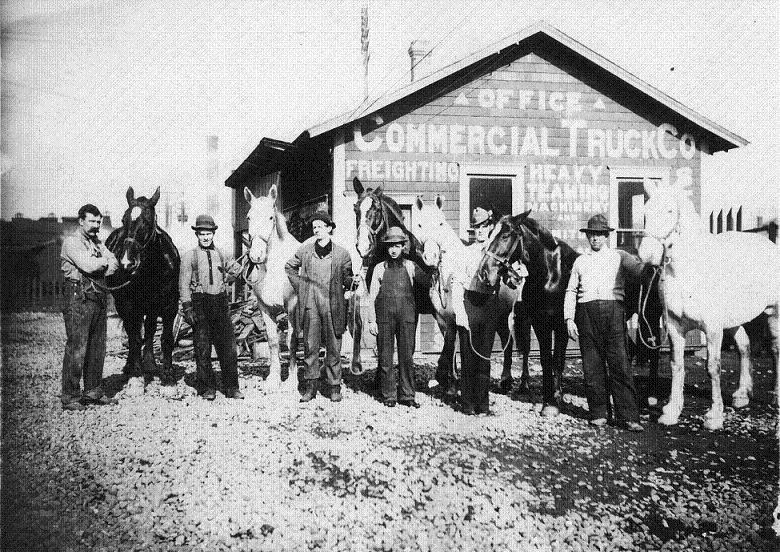Exposed: incompetence and waste in city government

In 1891, acting on a tip, an unnamed Tacoma Daily News reporter began an in-depth expose of the cost to maintain horses used for the upkeep of Tacoma’s streets. The first person he visited was Jay Haskins, Tacoma’s Superintendent of Streets. Mr. Haskins said that between January and early May, the city purchased feed from three different places: $300 worth from the Tacoma Trading Company, $322.21 from the Yakima and Tacoma Trading Company, and $45.56 from Birmingham and Tullis. Then the reporter asked Mr. Haskin how many horses the city had. And Mr. Haskin said he didn’t know. He thought seven but went on to say that a city council man named Clinton just bought a team. For an exact number, he referred the reporter to Mr. Clinton.
The reporter went to Mr. Clinton’s office several times but never succeeded in finding him there. In desperation he revisited Mr. Haskin and asked if there was a record of the city’s ownership of horses.
“Only at the time they’re purchased,†Mr. Haskin said. “That information is available at the city clerk’s office.â€
At the city clerk’s office, the reporter was told that the records only showed when teams were bought. And on April 26 the Board of Public Works purchased a team for $365. The clerk thought the city owned three teams. He suggested the reporter check with the Board of Public Works.
The reporter made an official request for the records from the Board. The person who responded, a man named Hodgins said he thought the city owned nine horses.
“I want to be sure,†the reporter said.
“Well,†Mr. Hodgins said, “inventory is only taken once a year, but I think the city owns nine horses: four teams and a cart horse.”
So the reporter went back to the Superintendent of Streets. “Are you sure the city has seven horses?†he asked.
“I don’t know,†Mr. Haskins repeated. “Sometimes horses are taken out of the fire department and police department and used on the streets, but I’m pretty sure there are seven.â€
The reporter then decided to visit the city stables. “Where are they?â€Â he asked.
“I don’t know,†Mr. Haskins said.
By this time, the reporter was in disbelief. “You don’t know?†he said.
“No,†Mr. Haskins replied, “but Mr. Clinton does.â€
The reporter found the location and on his way there ran into Harry Lillis, Tacoma’s fire chief
“Say chief,†he said, “Do you ever let any of your horses work for the city street department?â€
“Under no circumstances.â€
“Under no circumstances?â€
“Positively, under no circumstances.”
The city’s stable was in an old barn at 512 Seventeenth Street staffed by a stable boss and at least one helper. The second floor was full of election paraphernalia. The first floor had three road carts, two buggies and several road scrapers. The horse stalls were in the basement and had two teams.
“How’s the feed? Got plenty?â€Â the reporter asked. One of the feed bins had only a measure or two of oats.
“Enough for a couple of days.â€
Then the reporter asked about the hay. “I see you have only four bales of about 150 pounds each.â€
“That’s right.â€
“How many city teams are at work, today?â€
“Only one. They work nights.â€
“How many teams are kept in this stable?â€
“One.â€
“Where are the others?â€
“That’s all there is except the cart horse.â€
“Then the city only has five horses?â€
“That’s all.â€
The reporter gestured toward a team in one of the stalls. “Well, whose team is that with the blankets on?â€
“That’s Mr. Clinton’sâ€
“And whose is the other one?â€
“Well, some say it’s Mr. James’ and some say it’s the city’s, but I think it’s Mr. James’â€
“Do they do city work?â€
“No.â€
The reporter checked a second feed bin and it was full of fresh oats. “There’s fresh oats here, why do you need to order more?â€
“That belongs to Mr. Clinton and Mr. James.â€
“Then you feed their horses from this bin?â€
“Yes.â€
“And the bales of hay are theirs, also?â€
“Yes.â€
“So the city is only feeding five horses?â€
“That’s all. Sometimes fire department horses are sent here to do a little work and then they’re fed, too.â€
The reporter returned to the newspaper office and called the three companies that had been selling the feed to the city. None of them had sold hay or grain to either Mr. James or Mr. Clinton.
He summarized his findings as follows: the city stable boss says the city’s street department owns five horses, the Superintendent of Streets says it owns seven horses and the Board of Public Works says it owns nine. From Jan. 1 until April 26, the monthly feeding charge was $548.11 or $137.02 a month.
He also worked out the charges depending on how many horses the city actually owned: three horses, $45.67 a month, five horses, $27.40 a month, and seven horses, $19.57 a month. Then he posed the question: can a horse be fed for $19.57 a month?
Livery stables weighed in and said that feed, bedding, water, currying, and boarding a horse ran from $22.50 to $25 a month. Draymen and teamsters said their monthly charges were from $13 to $18 but $15 was a good average.
Figuring in the stable boss’s wages at $60 a month added $8.55 to the cost and care of each horse. That didn’t include water, bedding, renting the barn and additional stable hands. The reporter said it would be profitable for the city to board its horses at a livery barn for $25 a month.
Of course, how much would be saved by doing this depended on how many horses were involved. Even if it owned nine horses, taxpayers had to pay more than a livery stable would charge.
The reporter turned all the figures over to a third City Councilman who promised to investigate.


 By Hugh Straley, MD, Chief Medical Officer, Soundpath Health
By Hugh Straley, MD, Chief Medical Officer, Soundpath Health